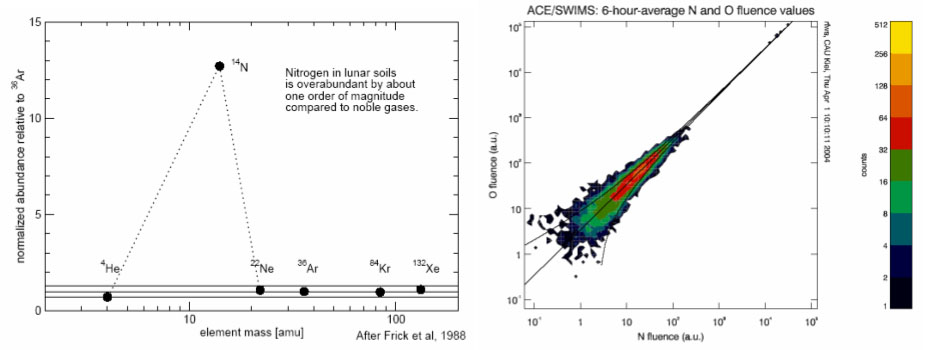
| ACE News Archives | ACE News #79 - April 5, 2004 |
Subscribe to ACE News |

The formation of the Moon led to a strong depletion of volatile elements (e. g. noble gases and nitrogen), therefore, noble gases in lunar soils did not originate in the Moon - they are not indigenous.
The Moon and its soil is constantly bombarded by the solar wind and by energetic particles of solar and other origins. Certain lunar soil minerals retain most noble gases and nitrogen to a remarkable degree, allowing studies of the history of the solar wind and inferences about solar activity in the distant past.
In order to limit possible solar contributions to this puzzle, we have investigated the variability of the elemental abundance of nitrogen in the solar wind by comparing it with that of the most abundant heavy ion, oxygen, which is often used as a reference element for composition studies. Using the excellent mass-resolving capabilities of SWIMS, we measured 6-hour nitrogen and oxygen fluences and compared them with long-term (yearly) averaged fluences.
The figure to the right shows the occurrence of 6-hour average oxygen fluences from 1999 through 2003 plotted versus the corresponding N fluences (both measured in arbitrary units, a.u.). The few points in the upper right corner show yearly accumulated fluence values. The solid straight line shows the average solar-wind N/O ratio; the curved lines show the 3-sigma confidence limits on the N fluence value given the corresponding O fluence. Clearly, the N/O ratio nowhere departs significantly from the average solar-wind value. It is consistent (to within 3-sigma), with a constant value, lending further support to the idea that most lunar nitrogen must indeed have originated in a non-solar source.
Submitted by F. Wimmer-Schweingruber, Institute for Experimental and Applied Physics (IEAP), University of Kiel, Germany.
Last modified 05 April 2004, by